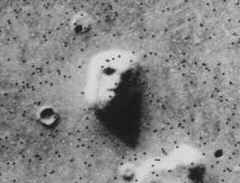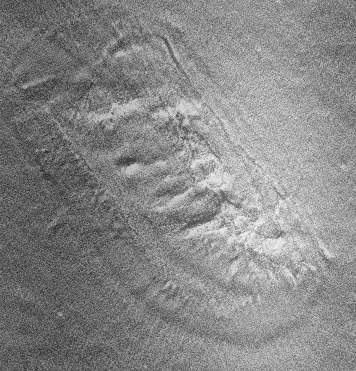Another conspiracy theory went. The face turned out to be a natural phenomenon, no less interesting
Avi Blizovsky
The legendary face on Mars filled tabloid covers, inspired theories about extraterrestrial civilizations, and even starred in a Hollywood movie. But high-resolution images taken from satellites orbiting Mars took the mask off the face and showed that it was simply a natural rock with an unusual shape.

25 years ago, NASA's Viking 1 spacecraft orbited the human planet, photographing potential landing sites for the Viking 2 spacecraft that followed. Then came the sensation. As the camera zoomed in on an area on Mars called Cydonia, the spacecraft observed what appeared to be a shadowy human face, complete with darker eyes, a narrow nose, and a sullen mouth, giving the configuration the overall appearance of an Egyptian pharaoh.
NASA scientists realized that sunlight plays an important role in the trick and after all it is just one table mountain among many in the Sidonia area.
However, the image of Viking excited the imagination of the public. The over 3 kilometer object led to the conclusion that the planet was once home to intelligent creatures.
NASA rejected this idea because the agency wanted to hide such knowledge, the link theorists insisted. The agency had to wait almost a generation to get another look at the bone.
Compared to Viking, whose resolution was very low, the Mars Global Surveyor could see objects the size of an airplane when it reached its orbit around Mars in April 1998. "We photographed the face the first time we could get a good look at it," says Jim Garvin, a NASA scientist. In charge of Mars.
The image, ten times sharper than the one obtained by Viking revealed the face, and found that it was merely a natural bone. Some people were not convinced. They claimed that Viking photographed the face in the winter season, and perhaps the seasonal fogs hid the face and caused distortions in viewing it. they claimed.
The surveyor took some close-up photos in April 2001, when summer arrived in the area. Without clouds or other shadows, it finally became clear that this is a table mountain whose sydonia is dotted with many like it.
NASA released these images this week, along with other Servier observations that revealed the truth. The spacecraft's laser surveyor, which can measure the exact height of any part of the bone to within 30 centimeters, found no evidence of an eye, nose or mouth.
"All its dimensions are similar to other table mountains. This mountain is not exotic in any way," said Garvin.
Nevertheless, planetary geologists are very interested in the Table Mountains of Sidonia, which is an unusual transition zone between smooth valleys in the north and high, cratered plateaus in the south. Some theories say that Sidonia was once a coast of ancient Oceanus.

"Proponents of the ocean theory argue that table mountains are what you would expect to see near the coastal boundary, but there are still many other possibilities." Garvin said, detailing that it is possible that these are landslides left after glaciers, that these mountains were shaped by winds, or that they are tectonic shifts (like the movement of the plates on Earth). Such forms can be seen in the western United States. he added.
Maybe only a manned field trip there will solve the problem. And for such a case, Gravin prepares a XNUMXD map of natural paths that climb to the top of the best-known Red Table Mountain.
"The beginning of the climb will be easy, with only a few steep sides here and there. It will take two hours to reach the top, but it will be worth it because the view from there will be spectacular." However, Gravin adds that it is advisable for the traveler to bring a large supply of water and oxygen.
